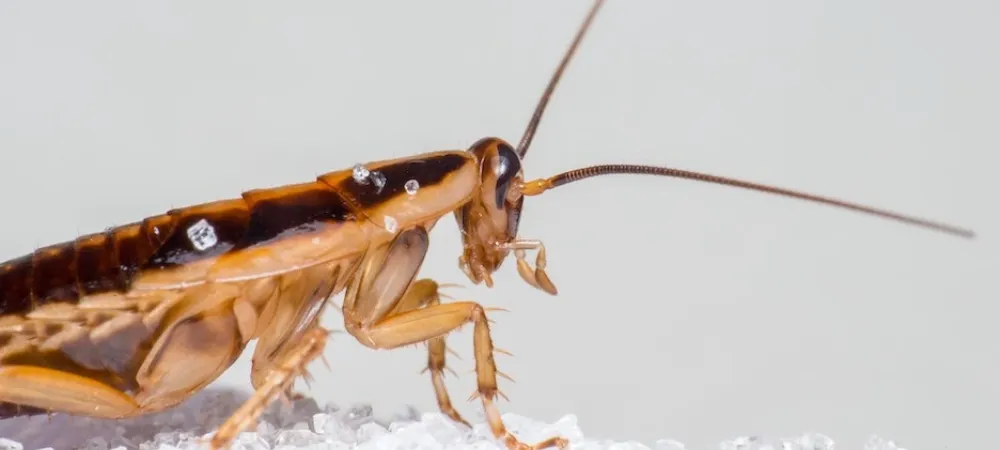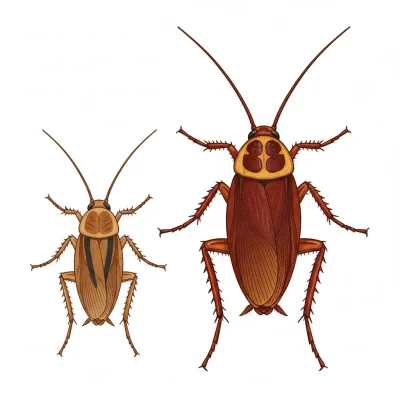German Cockroach vs American Cockroach

Two of the most common intruders in homes and businesses are the German cockroach and the American cockroach. While both are unwelcome guests, they have very different habits, appearances, and challenges when it comes to getting rid of them. Understanding the differences between these two species is the first step in effective pest control.
What's the Difference Between German & American Roaches?

When it comes to identifying cockroaches, spotting the difference between German and American species is important for effective pest control. Take a look at the diagram below to see how they compare side by side.
German cockroaches are much smaller, growing to about ½ inch long. They have two distinct dark stripes running down their pronotum (the shield-like area behind their head) and are light brown in color. Their wings cover the length of their body, but they don’t typically fly.
American cockroaches, on the other hand, are much larger—usually between 1.5 and 2 inches long. Instead of stripes, they have a yellowish, figure-eight pattern on their pronotum and a reddish-brown body. Their cerci (the small appendages at the rear) are noticeably longer, and their egg capsules are darker compared to the German cockroach.
Are German Roaches Harder to Get Rid of?
Yes — German roaches are harder to get rid of than American cockroaches. Their small size allows them to hide deep in cracks and crevices, and they reproduce at an incredibly fast rate, with each female producing dozens of offspring from a single egg capsule. This means even a few roaches can quickly turn into a major infestation if left untreated.
Unlike American cockroaches, which are larger and easier to spot, German cockroaches often go unnoticed until their numbers are overwhelming. Because of this, professional pest control is usually the most effective way to eliminate them completely.
How Do You Get Rid of German Roaches?
German roaches can be notoriously difficult to eliminate, but with the right approach, you can get them under control. Here’s how you can tackle an infestation effectively:
- Targeted gel baits: Place gel baits directly in corners, under sinks, behind appliances, and inside cabinets—anywhere German roaches hide. Unlike sprays, baits are carried back to the nest, killing others in the colony.
- Boric acid dust in cracks: Apply a thin layer of boric acid in wall voids, under appliances, and behind baseboards. German roaches avoid open spaces, so putting powder in hidden areas ensures they contact it.
- Sticky traps to monitor activity: Set traps near hot spots to track population and identify where the infestation is strongest. This helps you focus treatment effectively.
- Remove food and water sources meticulously: Even crumbs or a small leak can sustain a colony. Wipe down counters, store food in sealed containers, and fix leaks under sinks.
- Deep cleaning behind and under appliances: Roaches love warm, dark spaces. Pull out refrigerators, stoves, and dishwashers to remove eggs and hiding spots.
- Repeated, targeted treatments: German roaches reproduce quickly. One round of treatment rarely works—reapply baits and dust every few weeks until activity stops.
- Call a professional: For severe infestations, a licensed pest control expert can provide comprehensive treatments and ongoing prevention.
How Do You Get Rid of American Roaches?
American cockroaches are larger, hardier, and less likely to infest kitchens like German roaches, but they can still be a serious problem. Getting rid of them requires a slightly different approach:
- Eliminate outdoor attractants: Keep mulch, leaves, firewood, and compost piles away from your home’s foundation. American roaches often enter from yards or sewers.
- Seal entry points: Check doors, windows, vents, and foundation cracks. Even small gaps can allow these roaches inside.
- Reduce moisture: Fix leaky pipes, faucets, and drains. American roaches are attracted to damp areas like basements, crawl spaces, and bathrooms.
- Baits and traps in key areas: Place gel baits near water sources, in basements, and around entry points. Sticky traps help track activity and locate hidden nests.
- Use insecticide sprays sparingly: Focus on cracks, crevices, and outside perimeter areas. Avoid broad spraying indoors; it’s less effective against American roaches that mostly hide outside.
- Maintain outdoor cleanliness: Keep gutters clean, trim shrubs, and remove standing water. Reducing harborage areas outside limits the number that make it indoors.
- Professional pest control for large infestations: Because American roaches often live outdoors and in sewers, a licensed pest control company can target both indoor and outdoor populations effectively.
Professional Cockroach Control in Pennsylvania
Frequently Asked Questions
Can I handle a cockroach infestation myself?
Small infestations may respond to baits and cleaning, but both German and American roaches can be tough to eliminate completely. Professional treatment ensures faster, long-lasting results.
Do cockroaches carry diseases?
Yes. Both species can spread bacteria, trigger allergies, and contaminate food. Prompt control is important for health and safety.
How can I prevent roaches from returning after treatment?
Keep food sealed, fix leaks, declutter hiding spots, and seal entry points. Regular inspections and professional treatments can also help prevent reinfestation.
How can I tell if I have German or American cockroaches in my Pennsylvania home?
Look at their size, color, and behavior. German roaches are small, light brown, and often cluster in kitchens or bathrooms. American roaches are larger, reddish-brown, and usually found near basements, drains, or outdoor entry points.
